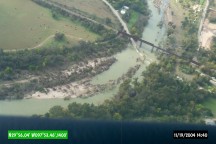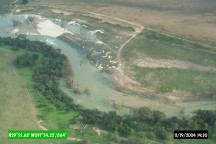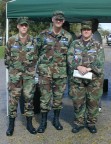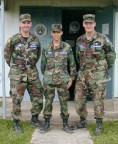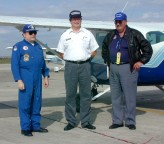Writing Exercise Editorial Version
Example of an Article Written as an Editorial – Nov. 26, 2004
A CAP Search and Rescue Mission – A Personal Point of View
by 1st Lt. Arthur E. Woodgate, Public Affairs Officer, David Lee “Tex” Hill Composite Squadron, Texas Wing
SAN MARCOS, Texas – It was an official CAP Mission. The cold numbers of quasi-military mission language, monotonously and relentlessly sequential, lumped this event with many others, some devastating in their scope and proportions, others meriting a mere footnote in a regional weekly newspaper, even others forgotten almost the instant they occurred. Some missions will be kept alive in thousands of hearts, who will continue to respond to an emptiness that touched all those who came near it. Indeed, the official numbers fail to give true dimension to this particular mission. As tragedies go, as the news media measure it, it was a minor one, an intimate one, a singular personal loss for a local family, and a promising individual life unfulfilled, truncated, inexplicably erased from the predictable lives of those left behind. And so avoidable! A tragic error at the wheel of a car that could have been a simple laughing matter under different circumstances. Yet however silly the error, this time, it cost a life. A senseless loss. An irrevocable act of destiny.
On the night of Sunday, Nov. 14, 2004, Laurie Piñeda, a young woman of 24, a veteran and decorated U.S. Army soldier, lost her life. She did not fall in combat, neither was she the victim of some sudden and unforgiving disease. She simply misjudged when she put in gear the car she was driving and, instead of backing out, plunged forward into the rushing waters of the Blanco River, just North of San Marcos, TX, at the spot shown in the aerial photo at left. Normally, this is a quiet bit of water, bubbling merrily by with a pleasant enough sound, hardly noticeable in the narrow channel it has carved for itself between grassy, lightly treed expanses of extended riverbed. A river not really worth the name … until the rains come. The road crossing, dwarfed by the railroad bridge high above it, is a slightly elevated concrete bridge, normally quite friendly. But not on that Sunday night. The river had already risen dangerously above the roadway, on its way to a high level that has been estimated at between 15 and 20 feet above normal.
Laurie Piñeda was not alone in the car. Jason Schmidt, the lucky one, also 24, was with her. They both managed to leave the car as it was rushed away by the now furious torrent, and each found a precarious hold on life by grabbing branches of riverbed trees that offered themselves, emerging from the raging onrush. Miraculously, help arrived in the dead of night. Rescue workers heard their cries for help, launched a boat and braved the swollen river. They found Schmidt first and, with difficulty, took him aboard. Then started downstream, towards Laurie Piñeda, her cries now becoming less strident, then fainter, then ceasing altogether before they could reach her. So near, yet so far. They searched, and called out, and swept the river with their flashlights, but to no avail. They finally sought the safety of firm ground, dejected. The rescuer lives for the moment of success, is carried forward by the hope of being able to return someone in mortal danger back to the safety and sanity of “life as usual.” When successful, the rescuer has heard the litany of relief many times. “Thank you.” “May God bless you.” “I owe you my life.” The many expressions of gratitude and the single meaning of them all — “I’m so glad that it’s over” — “I’M ALIVE!”
When Monday, Nov. 15, 2004 dawned, the day following the tragedy that had unfolded in the dark of that previous night, it seemed clear that Laurie Piñeda was not likely to be found alive, but hope had not died out yet. Many civic groups, rescuers, volunteers, professionals, concerned citizens, friends, and members of her family searched anxiously from the high river banks, as they saw the waters of the Blanco River rise ever higher. The Civil Air Patrol’s David Lee “Tex” Hill Composite Squadron, in expectation of getting an authorizing mission number, sent an emergency ground team composed of 2nd Lt. Frank Bos (the squadron emergency services officer), Tech. Flight Officer Stephen White, Cadet Andrew Bos and Senior Member Derek Conaway. However, as the river’s surface continued to rise, so did the rescuers’ hope ebb. Soon enough, it became clear that this would be a recovery operation, not a rescue mission. The weather worsened, and it rained mercilessly — making it dangerous to even walk without slipping on the high river banks. When the downpour finally ended, the clouds wouldn’t lift, so that aerial reconnaissance was impossible. It was too dangerous for even helicopters to fly.
Late on Monday, Nov. 15, The Civil Air Patrol authorized Mission Number 05-117, in answer to the request put in by the David Lee “Tex” Hill Composite Squadron, part of Group 8, Texas Wing. Immediately, 2nd Lt. Frank Bos, the squadron emergency services officer, with the help of his son, Cadet Andrew Bos, made the necessary calls, filled out the preliminary paperwork, assisted the squadron commander in taking care of some of the many details involved in launching a mission, and paved the way for others to pick up where they would leave off. Because a rescue mission is not a job that can be handled by a single individual. In fact, it is a job that, by its very nature, defines the meaning and concept of team-work. The vast majority of Civil Air Patrol members are volunteers who give freely of their time and talent for no pay — occasionally, a small sum reimburses them for some actual expenses. Yet, its members are always ready to come to the aid of the community.
Neighboring CAP squadrons were contacted, seeking volunteers. But it isn’t easy to find help during the week, when most CAP members need to work at a regular job to earn a living. A ground team was assembled in spite of the difficulty, thanks to the understanding and cooperation of civic-minded business owners, and in the case of cadets, parents and school authorities. Preparations were made for reconnaissance flights, should visibility improve. The detail and routine of official activity and organized effort took over, as we did what we had been trained to do. The rush and bustle of the moment put our emotions on hold, all of us galvanized by the need to do something, get busy, feel useful, be part of the solution. On Tuesday, Nov. 16, Cadet Peter French and Lt. Col. Deborah French (not related, both from Pegasus Composite Squadron) joined our TFO Stephen White (center, at right). The Incident Commander had them search a specific area downstream, near Interstate 35, in the hope of finding some indication. Any indication. But they were “unsuccessful,” as the cold language of mission results puts it. The cloud ceiling finally lifted, visibility improved, and the helicopters came. They are wondrous and useful things, helicopters, but their activity pre-empts the near skies and makes it impossible to deploy a camera-fitted Unmanned Aerial Vehicle under them. The rescue worker in charge of this expensive piece of equipment fretted that darkness was coming, and that he wouldn’t be able to fly his mission. We couldn’t fly ours above them, either, and our Cessna 172 just sat on the runway at the San Marcos Municipal Airport, ready but prevented from taking off.
We left for the evening, not knowing whether we would be asked to return. Then, CAP National extended the mission, so the search marched on. The ground teams combed the area farther and farther downstream, hoping to find some indication of life but, in their heart, knowing that none would be there. At one point, someone sighted circling buzzards, which is an indicator of a possible recovery site. But no, it was a false alarm. It was just a relatively quiet, circling sidewater off the river’s main stream with a few floating dead fish in it. (Checking this out was both a relief and a disappointment.)
On Thursday, Nov. 17, Maj. Russell Melvin, the Texas Wing emergency services officer, was on site to provide leadership and expertise. With nearly clear skies, and the helicopters gone, our air crew (left), with Capt. Leroy Friesenhahn (squadron deputy commander of seniors, center) at the controls, and Capts. Dave Badal (squadron commander, right) and Roland Coyote (Group 8, left) as scanners and photographers finally was able to fly its mission. A sortie that yielded many images of the still swollen but considerably lowered river, as requested by the Incident Commander, who later expressed his gratitude and pleasure at our contribution. Our up-to-the-minute photography would make the search easier for all personnel, not just our own ground teams. Another CAP ground team went out, composed of 2nd Lt. Daren Jaeger, Cadet Steven Hamman, and TFO Stephen White (right). Some clothing was found during their search, but it didn’t match the presumed victim’s. By now the water level had subsided considerably, and they were able to walk and slosh on the lower banks of the river. 1st Lt. Jaeger, upon returning from the mission, commented that they could clearly see the high water mark on the steep river banks, a dark and wet band 10 ft or more above their own heads as they walked along. This estimate was in keeping with the official figures. They also reported that the amount of debris present on the extended riverbed was phenomenal. “Nobody could live through all that,” they all said.
That Monday, Nov. 15, with the incident still fresh in the public eye, the news media had been very much in evidence. Their trucks, parked by the road, slowly and deliberately deployed their cold flowers of technology: very tall, telescoping metal stalks with dish antennas on their end. The news crews came and went, the camera-ready announcer grasping a clipboard, a folded notebook, a microphone, a purse. Trailing the announcer, the ubiquitous luggable TV camera followed, firmly held in capable and (through necessity) very strong hands. This new, unyielding, man-made forest of metal-stalked dish antennas rivaled the old live oaks and cedars that surrounded them. The wind kicked up, and the trees swayed at different rhythms, as if in whispered protest against this stiff mechanical invasion. An invasion that thinned out gradually, as the search failed to produce “positive” results and feed yet more news-worthy information. An invasion eroded by the daily pressure of news directors demanding fresh, sensational, and thrilling news appropriate for prime time airing.
One early afternoon, a Hispanic woman arrived in a large, not-new, well-cared-for American sedan, and quietly asked where she could deliver some food. No, she was not a caterer. Rather, she appeared to be a member of Laurie Piñeda’s own family. Or a close friend. Someone trying to look after the living, to do what she could to help them find Laurie, to thank others for their generous efforts, and help bring closure to Laurie’s family and friends. She, too, was trying her best, the only way she knew how.
As of this writing, Laurie Piñeda is yet to be found. It is generally agreed that she probably lies tangled in submerged vegetation or a heavy, sunken object, and that she won’t be found until the Blanco River returns to its usual, gentle, shallow self. The rescue workers came not only from the cities of San Marcos and Austin but from the entire Central Texas region. They arrived, worked together, gave of their best, felt the agony of helplessness and failure, and got to know and respect each other. Fire departments, emergency medical technicians, dog teams, deputy sheriffs, search and rescue teams, boat teams with rescuers dressed in black wet suits, the Civil Air Patrol, many local and state police… They came from all walks of life, were of all ages, male and female, and above all – they cared. Some were graying and showed tired and craggy faces; others glowed in the fresh bloom of youth, looking at life with shiny and clear eyes. Some were wet and muddy from the search, others clean and stiffly starched as they emerged from a newly arrived bus. They were all different, all willing, and something unified them all. They hurt deeply. And they hoped for a miracle.
Next time, perhaps.
NOTE: On March 19, 2011, fishermen found a partial human skull on the margin of the Blanco River. After forensic examination, it was determined that it belonged to Laurie Piñeda, bringing closure to her family.
Last updated: 09/03/15



